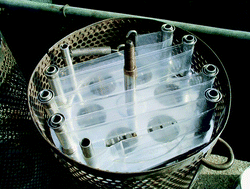The uptake characteristics of semipermeable membrane devices (SPMDs) and polar organic chemical integrative samplers (POCISs) were examined for mono, di and tributyltin, triphenyltin, pyrene, benzo[a]pyrene, 4-tert-butylphenol, 4-n-nonylphenol, PCBs 77 and 153, PBDE 47, lindane, triclosan and DDT. Exposure in a flow through system continued for 28 days with samplers removed every 7 days in order to study the relevant uptake kinetics. Uptake remained linear for POCISs with sampling rates (Rs) of up to 0.2 L d−1. For SPMDs uptake varied from linear to approaching equilibrium with Rs values of up to 14 L d−1. 7 out of 9 results for SPMDs could be explained by an empirical model (nonylphenol and lindane were exceptions). None of the four organo-tin compounds studied were detected in POCISs and only tributyltin was accumulated significantly by SPMDs. The establishment of these sampling rates allows the calculation of time weighted water concentrations for several important contaminants. Using presented methods, sampling rates and exposure conditions, theoretical detection limits for selected compounds by SPMDs were between 11–68 pg L−1, which is well below the environment quality standard proposed for those compounds that are included in the European Water Framework Directive.

You have access to this article
 Please wait while we load your content...
Something went wrong. Try again?
Please wait while we load your content...
Something went wrong. Try again?


 Please wait while we load your content...
Please wait while we load your content...